A problem in the history of science and technology
The quotations on Introduction and Conclusions invoke the history of science and technology in support of the view that science precedes technical innovations. This is a very broad issue, and raises questions about what is meant by science and technology, and what the the origins of technical innovation are. The Technology, research, development, and science page looks at popular and expert views on these questions, in recent history and current practice. This puts into context, and calls into question, the idea that basic research spontaneously produces knowledge which is then consumed by applied science to produce technical innovation. Broad views like this can only be justified if they are ultimately supported by specialist investigations into particular cases in the histories of science and technology.
These disciplines do not subscribe to broad simplistic generalisations:
By 1972 most historians of science and technology had accepted that technology is knowledge, not merely applied science. This was most graphically demonstrated at a meeting held in that year… Ostensibly on the topic "The Relationship of Science and Technology," the meeting was in fact an extended funeral for the old assembly-line or technology-as-applied-science view. Since 1972, historians have left that view behind. (George WiseGeorge Wise, Science and Technology, Osiris, 2nd Series, Vol. 1, Historical Writing on American Science. (1985), pp. 229-246, p236 ).
One case is particularly significant in these discussions:
The role of science and technology in the First Industrial Revolution is still contested. Some scholars, focusing on the textiles sector, argue that skilled and talented artisans with no scientific training were mainly responsible for the key inventions; others, with steam power in mind, hold that the links between science and the crucial inventions of the period were fundamental (Ó GrádaDid Science Cause the Industrial Revolution? Cormac Ó Gráda, Journal of Economic Literature 2016, 54(1), 224–239, http://dx.doi.org/10.1257/jel.54.1.224).
The latter scholars believe that they have established that, in the case of the origins of steam power, innovation has clearly been enabled by science. The innovation in question is the Newcomen-Calley fire engine of 1712, which was the first heat engine to work reliably and safely at superhuman power levels. The basis for their belief is the subject of this page.
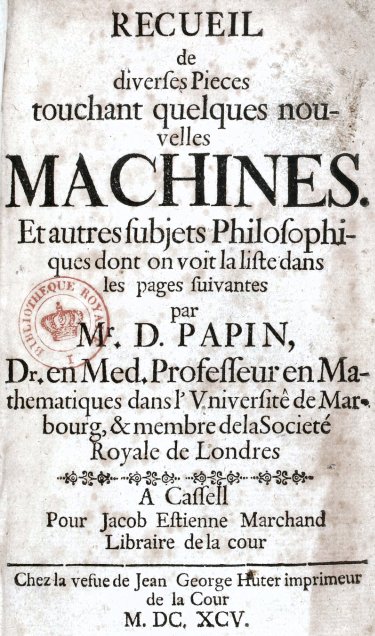
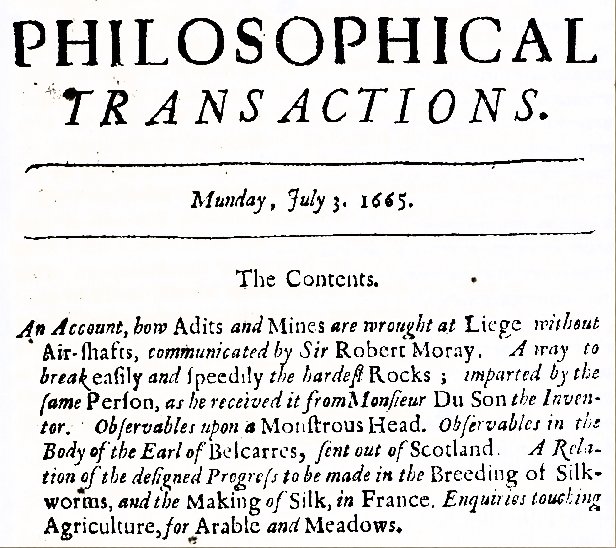
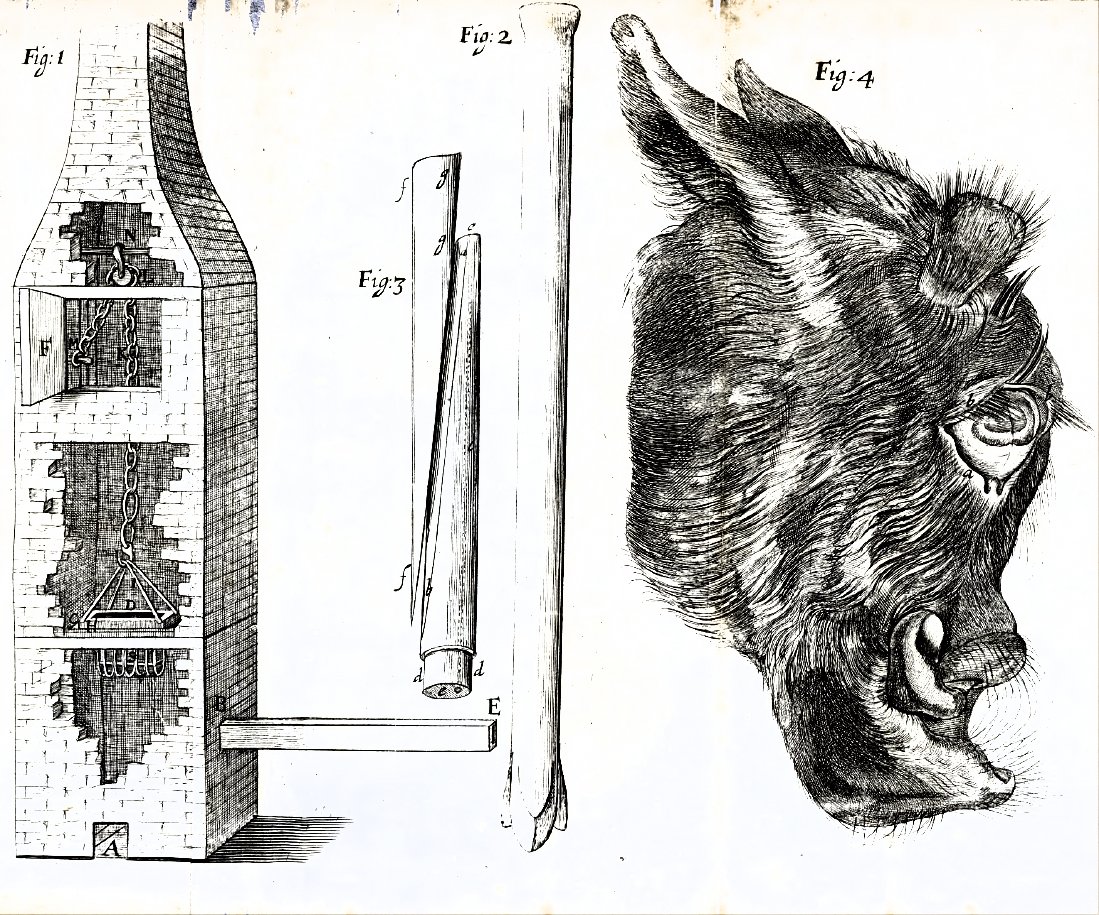
In an overview of historical research into the relationship between science and technology HongSungook Hong (1999) Historiographical layers in the relationship between science and technology, History and Technology, 15:4, 289-311, DOI:10.1080/07341519908581950 remarks that: No other issue in the history of science and technology has been so exhaustively debated without consensus.
He describes how actual case studies are interpreted in differing ways according to the author's understanding of what constitutes science or technology. This issue of interpretation may also be a problem in the case of steam power. The issue is addressed for more recent history on the Technology, research, development, and science page. The finding there is that research intermingles science and technology to the extent that they cannot be clearly separated. There is, however, a significant distinction between academic research and other research and development.
The material examined on this page reveals a similar situation in the seventeenth century. Denis Papin, whose research work is cited in the studies on this page as most strongly connecting science to the new technology of steam power, also designed steam powered devices and had prototypes made. This was normal at the time: the first learned societies were formed under the influence of the view that the real and legitimate goal of the sciences is the endowment of human life with new inventions and riches
(Bacon). The issue, though, is not whether this sort of scholarly research should be labeled as science or technology; the issue is whether its results contributed to the development of the new technology, or not. The research work was conducted by members of learned societies and published by them, whereas the successful steam engine was developed by an ironmonger and a plumber associated with a mining community. These are separate groups of people, so the issue may be decided by whether there is evidence, direct or indirect, that the ideas of the scholars were conveyed to the developers.
The origins of early steam power are a longstanding subject; on this page over twenty studies are examined, published over the last two hundred years. Some studies take the view that the development was impossible without the scholarly ideas, and so the developers must have become aware of them by a plausible means. Others assert that these ideas would not have contributed anything positive to the development effort, even if they had been conveyed. Both views survive to the present day, but it is the former that is prevalent, and is most closely examined here.
The authors of the studies have a range of affiliations. In the nineteenth century, when reciprocating steam engines were still a hot topic in engineering, many treatises were produced by engineers which included material on the early history of the engines. In the earlier part of the twentieth century the topic was more addressed by conservators, and after that by academic historians. There appears to be a strong correlation between the affiliation and interests of an author and the affiliation of the persons they give credit to for the new technology.
Prologue
John Robison (1797), article on Steam in Encyclopædia Britannica, Volume XVII, page 747
There are to be found among Hooke's papers in the possession of the Royal Society, some notes of observations, for the use of Newcomen his countryman…One passage is remarkable.Could he (meaning Papin) make a speedy vacuum under your second piston, your work is done.It is highly probable that, in the course of this speculation, it occurred to Mr Newcomen that the vacuum he so much wanted might be produced by steam, and that this gave rise to his new principle and construction of the steam-engine.
This appears to show a direct communication between Hooke and Papin, fellows of the Royal Society, and Newcomen. Subsequent research has been unable to confirm the existence of Hooke's note to Newcomen, and has found other errors in the Britannica article.
James Watt, prefatory letter in A System of Mechanical Philosophy, vol II, On the Steam Engine (1822).
He [Dr Robison] afterwards, in the dedication to me of his edition of Dr Black's Lectures upon Chemistry, goes the length of supposing me to have professed to owe my improvements upon the Steam-Engine to the instructions and information I had received from that gentleman, which certainly was a misapprehension,…
James Watt is here taking the opportunity to correct one of several errors into which Dr Robison had fallen occasioned by too great a reliance on the powers of his extraordinary memory at a period when it probably had been weakened by a long state of acute pain, and by the remedies to which he was obliged to have recourse
. It seems that Professor Robison had a tendency to assign undue credit to scholars, at the expense of practitioners.
The treatises
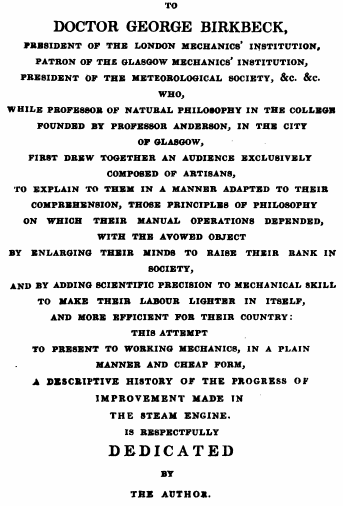
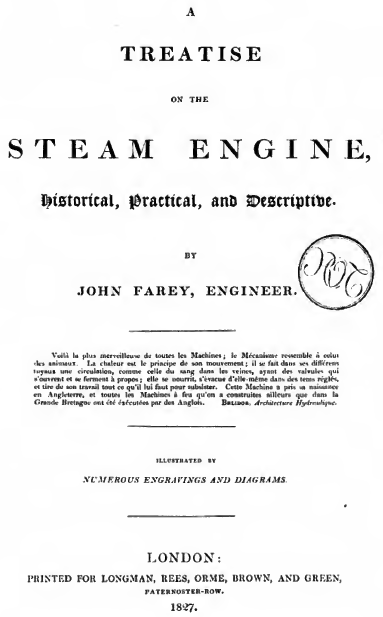
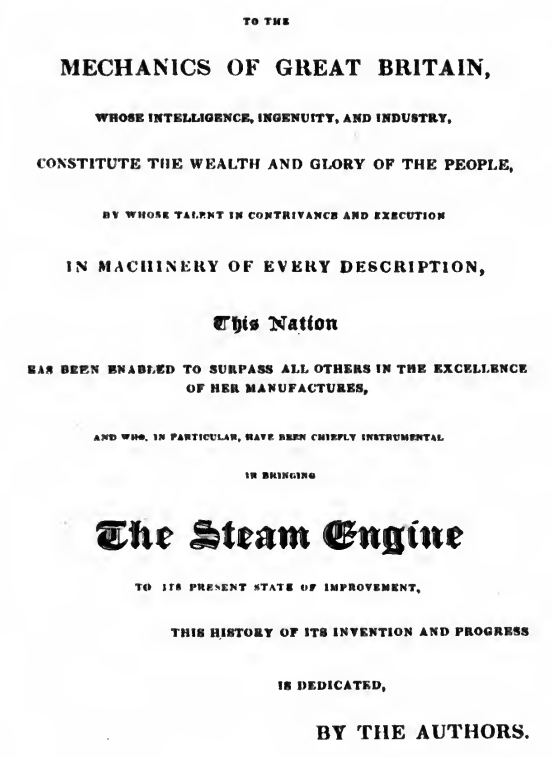
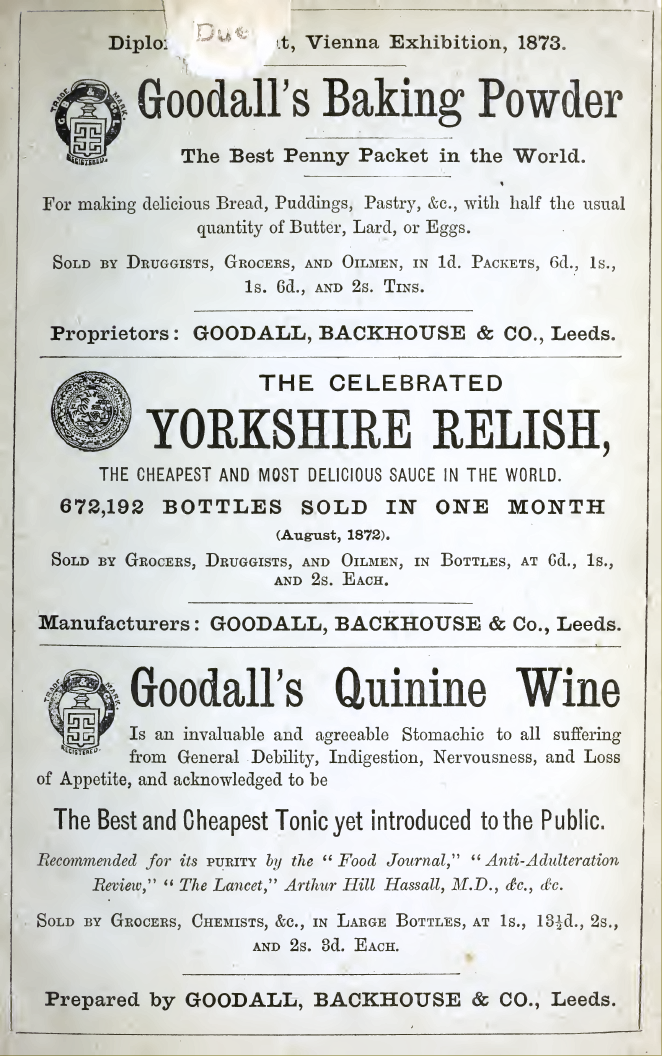
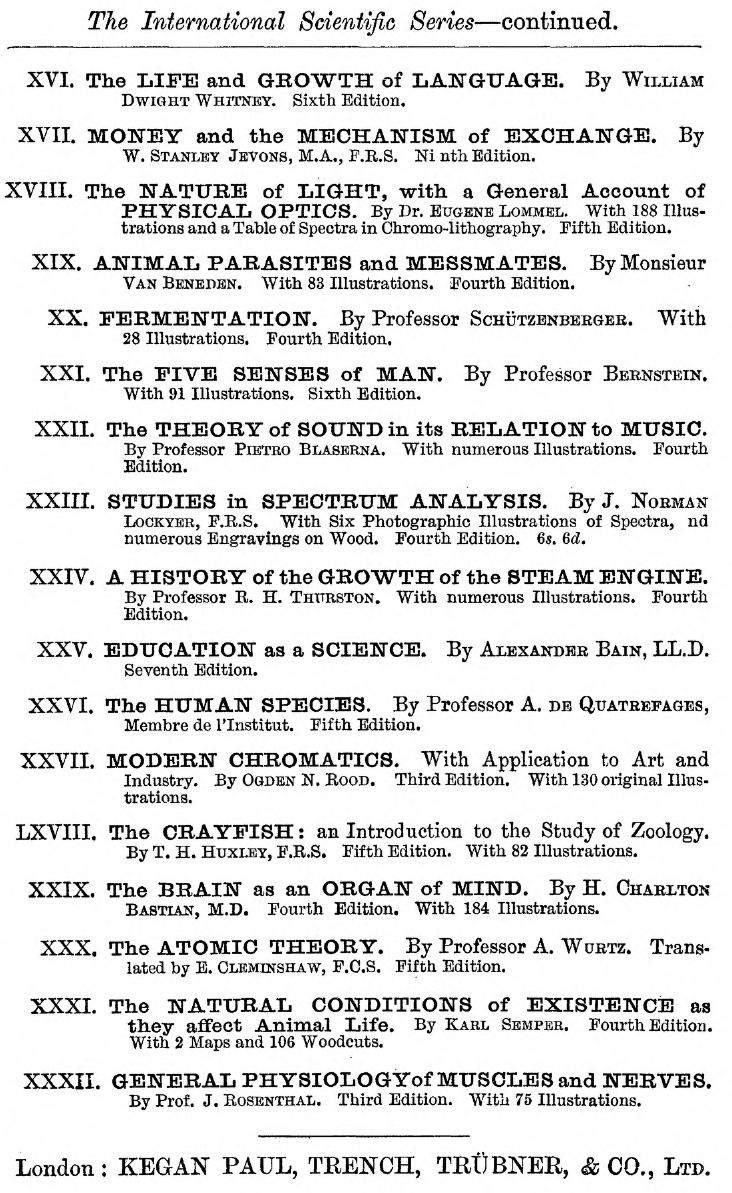
The eight volumes listed below were written by and for engineers. Seven of them have a nominally historical approach, but they are not works of historical research: they are practical compendiums intended for a readership involved in making and running steam engines. The early origins of steam power before Newcomen were only of interest as background, and occupy about 250 pages out of a total page count of over 3500 for the eight volumes. Six out of the eight report the communication between Hooke and Newcomen which appears now to have been one of Robison's false memories.
The list includes relevant quotes from the volumes, six of which express definite views on the role of the ideas of individuals in the process of invention. The accompanying images are chosen to illustrate the cultures of their expected readership.
Robert Stuart: A descriptive history of the steam engine. 1824
p(vi). Indeed, there is no machine or mechanism in which the little that theorists have done is more useless. The honour of bringing it to its present state of perfection, therefore, belongs to a different and more useful class. It arose, was improved and perfected by working mechanics—and by them only; for tradition has preserved to us the fact of Savery having begun life as a working miner; Newcomen was a blacksmith, and his partner Cawley a glazier; Don Ricardo Trevithick was also an operative mechanic; and so was the illustrious Watt, when he began, and after he had made his grand improvements.
John Farey A treatise on the steam engine, 1827
p4. ...the steam-engine is the invention of a few individuals, in the first origin it was the result of philosophical inquiry, and the production of very ingenious minds; and almost every material alteration in its principles of action has been an application of scientific knowledge.
p(v). The practical and descriptive part [of this treatise] is intended to form a course of instruction for professional students, in the practice and principles of making and using steam-engines.
p56. Dr Robison observes, thatthe contrivance and direction of such works constitute the profession of the Engineer; a profession which ought by no means to be confounded with that of the mechanic, the artisan, or manufacturer. It is one of the liberal arts, as deserving of the title as medicine, surgery, architecture, painting, or sculpture. And whether we consider the importance of it to this flourishing nation, or the science that is necessary for giving eminence to the professor, it is very doubtful whether it should not take place of the three last named, and go pari passu with surgery and medicine.
Elijah Galloway, History and Progress of the Steam Engine, with an extensive Appendix by Luke Hebert (London, 1831)
p15. This, as far as discovery goes, entitles Papin to the merit of having first invented the well-known Atmospheric Steam Engine: and, probably, had he followed up the idea by actual experiment, we would have had to record him as the man who first brought it into successful operation. But the greatest merit is not always due to the inventor; thousands of the most brilliant discoveries have perished for want of industry or talent to foster them. The man who first invents and afterwards struggles through every difficulty, and by the greatest sacrifices and perseverance brings it into actual practice, perhaps outsteps the projector of the most refined contrivance of which history can boast.
Paul R. Hodge The Steam Engine: Its Origin and Gradual Improvement, from the Time of Hero to the Present Day 1840
p(v). To supply the Mechanic with a concise history of the invention and subsequent improvements of the Steam Engine, from the earliest period to the present time, together with such practical rules and explanations as would enable him to design and construct a machine of any required power, and of the most improved form, for whatever purpose desired, has been the main object of the Author of third volume.
Robert Scott Burn, The steam engine: its history and mechanism, being descriptions and illustrations of the stationary, locomotive, and marine engine, 1875.
p25: With reference to the claim put forward by the advocates of Papin and Savery as to their discovery of the principle of the formation of a vacuum by steam, it is very evident that neither could substantiate his claim, as the fact that a vacuum could thus be formed was known before their time ; long before, indeed, the principle of atmospheric pressure itself was established.
Robert H Thurston A history of the growth of the steam-engine. 1887, 1901
p55 At the beginning of the eighteenth century every element of the modem type of steam-engine had been separately invented and practically applied. ...It now only remained for the engineer to combine known forms of mechanism in a practical machine which should be capable of economically and conveniently utilizing the power of steam through the application of now well-understood principles, and by the intelligent combination of physical phenomena already familiar to scientific investigators.
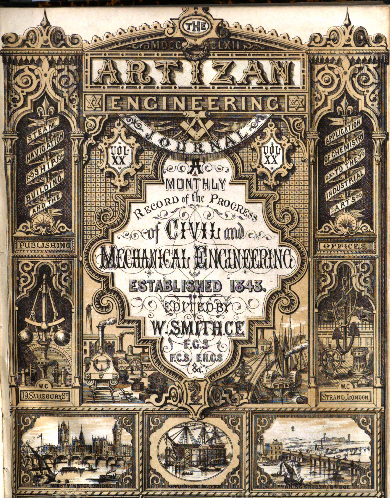
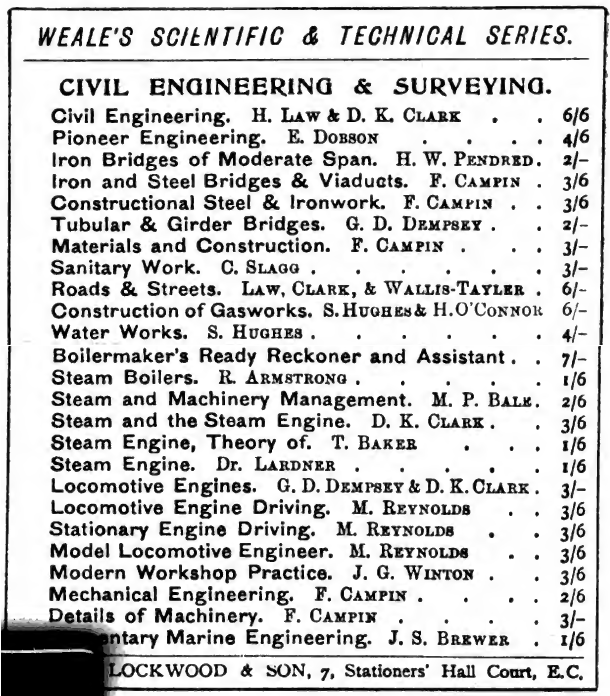
Two of the treatises do not refer to Robison's report of communication between Hooke and Newcomen:
The Artizan Club, ed John Bourne, A treatise on the steam engine, 1846, 1853.
p1. The mere men of speculation, who have suggested modes of doing things, but have never done them, are not to be ranked with those who have really accomplished something, in a case where the whole difficulty of the task lies in its practical achievement, Whatever else these ingenious persons may be, they are certainly not among the number of the improvers of the steam engine; and their claims, if to be considered at all, ought in strictness to be considered as the claims of a distinct class of persons. Nor can the merit of such a class, under ordinary circumstances, be considerable, for there is nothing more easy than to originate vague ideas of improvement, though it is generally a very difficult thing to carry those ideas into successful practice.
D Kinnear Clark, An elementary treatise on steam and the steam engine. 1892
p84. The scientific knowledge of such men as Desaguliers, Emerson, Smeaton, Black, Robertson, and others were all brought to bear on the progress of the reciprocatory steam-engine. It also embraces the material leading inventions of the loaded safety-valve, piston and cylinder of the ancients; the tubular boiler and steelyard safety-valve of Papin, a French physician; the condensation vacuum and gauge-cocks of Savary, an English miner; of the beam, boiler-pump, injection-pump, and vacuum below the piston of Newcomen, an English blacksmith; the hand-gear of Potter, an English peasant boy; the fly-wheel of Fitzgerald, an Irish professor; the condenser air-pump, double action, parallel motion, and governor of Watt, a Scottish mechanic; the crank motion of Pickard, an English mechanic; the metallic piston of Cartwright, an English dissenting clergyman; the oscillatory cylinder, eccentric motion, and slide-valve of Murdock, a Scottish mechanic; and the double cylinder of Hornblower, an English mechanic. From these inventors' inventions, modern engineers select at pleasure to construct an efficient engine for the duty to be done.
Review
Among the engineers, seven of them express clear views on the value of scholarly research in the development of the steam engine. Five of these address the nature of innovation: they contrast how easy it is to speculate with how hard it is to make a practical advance, and how an advance depended on multiple diverse sources, and not on a single vague idea. They describe how the mechanical principles needed to develop the engine were available to the practitioners, with no outside help. Although they accepted the spurious evidence for a direct link between the scholars and the developers, they could see no evidence of any benefit from that connection. The illustrations at left and right show that these five authors were all addressing a readership of mechanics and artisans.
Two authors, Farey and Thurston, take the view that the design of the steam engine was derived from scientific knowledge and investigations. Farey, writing within a decade of the foundation of the world’s first professional engineering body, is committed to elevating the social status of the engineer above that of the artisan. Sixty years later, Thurston's work is published alongside that of a flourishing and respected scientific community.
Although there is a certain symmetry between the opposing views of the origins of the steam engine, in that both express a view acceptable to their readership, it is not complete. The authors who dismiss the contribution of the scholars address the nature of innovation, and take the trouble to justify their view, whereas the two who give little credit to the practitioners do not.
Three conservators
Three people who worked on the conservation of steam engines have made special contributions to understanding its early history. Henry Winram Dickinson and Rhys Jenkins were founder members of the Newcomen Society for the Study of the History of Engineering and Technology in 1920. They began their careers as engineers, then early on became respectively a museum keeper and a patent examiner. Richard Hills, an engineer manqué, studied history then early in his career assisted in setting up the the North Western Museum of Science and Industry.
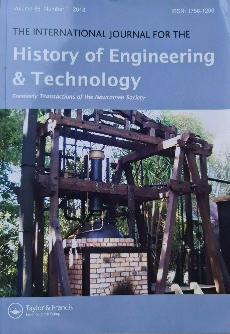
Rhys Jenkins, The Heat Engine Idea in the Seventeenth CenturyRhys Jenkins, The Heat Engine Idea in the Seventeenth Century, Transactions of the Newcomen Society, 17:1, 1-11. 1936
p6. In the story of the Newcomen engine it has been accepted as a fact that Newcomen had been in correspondence with Robert Hooke, Secretary of the Royal Society, and was indebted to him for at least a hint of the direction in which he should proceed. The only basis for this idea is found in the article on "Steam Engines" by Dr. John Robison (1739-1805) in the third edition of the Encyclopaedia Britannica, 1797, and what is said therein on this point is stated to be founded on a document which subsequent investigation has failed to find.
p8. It is clear that Robison's account, so far, is in the main an effort of the imagination.
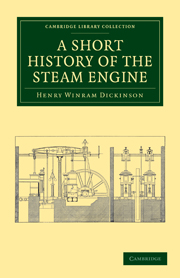
H W Dickinson, A short history of the steam engineH W Dickinson, A short history of the steam engine, Babcock and Wilcox Ltd 1938 , 1938
p29. When we look into the matter closely, the extraordinary fact emerges that the new engine was little more than a combination of known parts; a cylinder and a piston had been used by Guericke, Papin and others; the pump-bucket and the pump-handle were well known, although not on the scale now contemplated; the boiler with its setting was little more than a large brewer's copper; the layer of water on the piston to act as packing was a novelty but not a strikingly original idea.
R. L. Hills, A One-Third Scale Working Model of The Newcomen Engine of 1712R. L. Hills A One-Third Scale Working Model of The Newcomen Engine of 1712, Transactions of the Newcomen Society, 44:1, 63-77 (1971), (1971)
p65. Yet, as I hope will become clear in this paper, Thomas Newcomen’s engine shows that he must have had a remarkable understanding of the properties of steam and that he must have fully understood the latest scientific thought of his day. …in Thomas Newcomen’s engine we seem to have a completely new technological feat which does not owe its creation to earlier inventions and in addition was a major contribution to the advancement of civilisation.
These three authors combine mechanical insight with scholarly interest. They set up a framework for examining the origins of the steam engine. The glib story that Papin and Hooke were in correspondence with Newcomen at just the moment to set him in the right direction can be set aside. Any argument that their scientific research may have had some influence has now to be justified by showing that their results could have helped Newcomen, and have been available to him. That justification has to overcome the objections made by the engineers in their treatises above.
The step by step account of the reconstruction of a scale model reveals the technical advances needed for the development in detail. It can be used to test the argument about what was required for Newcomen to succeed. The steps can be analysed to see what kind of ability is required to execute them. If they are all accessible to an artisan willing to experiment and consult with other artisans, there is no reason to suppose a direct contribution from science. To show an indirect contribution from science it would be necessary to demonstrate that the capabilities of these artisans went beyond the prior arts of mechanics, thanks to the contributions of contemporary science.
The current position
The two excerpts below are both from An encyclopedia of the history of technologyAn Encyclopedia of the History of Technology, Ian McNeil, London: Routledge, 1990. 1990.
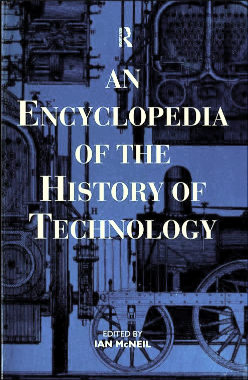
Ian McNeil, Introduction, p3:
For a short period in the seventeenth century scientists, mostly dilettantes, took a lively interest in the possibility of harnessing the power of steam, but little came of their curiosity. …Claims may be, and have been made for any one of these to have ‘invented’ the steam engine but, without question, it was Thomas Newcomen, a Dartmouth ‘ironmonger’, who devised and built the world’s first practical steam engine, which was installed for mine-pumping at Dudley Castle in 1712. There is equally little doubt that Newcomen was a practical man, an artisan with little or no scientific knowledge or any training in scientific matters. Science and scientists had little direct or indirect influence on the early development of the steam engine.
EFC Somerscales, Steam and internal combustion engines, p273
The discoveries that, when brought together by Thomas Newcomen in 1712, resulted in the steam engine were:...the Neapolitan scientist Giambattista della Porta described in 1601 the way in which a vacuum could be produced by the condensation of steam. ...The use of steam to accomplish this had to await the invention by Denis Papin, sometime between 1690 and 1695, of the piston and cylinder. ...With the demonstration of Papin’s engine, all the elements were available for manufacturing a reciprocating steam engine.
- The concept of a vacuum (i.e. a reduction in pressure below ambient)
- The concept of pressure
- Techniques for creating a vacuum
- A means of generating steam
- The piston and cylinder
These articles, in the same publication, show a clear cut separation of how the two views are presented. To demonstrate the role of science, the development of Newcomen's engine is analysed in terms of the concepts which preoccupied scholarly research, and in terms of mechanical elements that had also been employed in that research. The implication is that these were the sources which guided Newcomen as he developed the engine. At the time of writing, it is the second view that is quoted in the Wikipedia entry on the history of the steam engine. The background to why it is the second view that prevails is discussed in the next section.
The prevailing view
The view presented in the Wikipedia article on the history of the steam engine has considerable support from academic authors. Ten examples are listed below; their authors have a variety of research interests. Some are particularly assertive about the enabling role of science in the development of the steam engine, others are more reserved.
History of technology
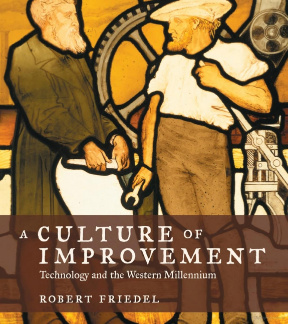
Robert D Friedel A Culture of Improvement‒ Technology and the Western Millennium Robert D Friedel, A culture of improvement: technology and the Western millennium, Cambridge, MA : MIT Press, 2007 2007.
p194: [Savery's] engine, however, did depend for its working on an understanding of some relatively novel perceptions of nature, particularly of the atmosphere.
p195: The idea that the atmosphere might be made to do the work of a piston engine was explored by a number of experimenters, but finding a good way to produce a vacuum eluded most of them—some even tried to explode small charges of gunpowder in a cylinder to remove the air, but with no success. The demonstration that the vacuum created by condensing steam could be made to do work, as shown in Savery’s ‘engine’, inspired others to experiment with steam in cylinders with pistons.
p260: The steam engine, as we have seen, was in some small part at least the product of experiments and descriptions of the behavior of air and of the atmosphere.
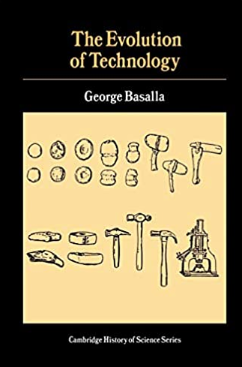
George Basalla The evolution of technologyGeorge Basalla, The evolution of technology, 1988 1988.
p93: Papin had discovered the key principle of an atmospheric engine and recognized that, given cylinders and pistons of appropriate size, it would be possible to do useful work with them. ...[Newcomen] was well suited to take Papin’s vague idea of an atmospheric engine and turn it into a functioning physical device that could be profitably used to pump water out of mines.
p97: The prehistory of the steam engine includes the conceptual understanding of the vacuum, an intellectual activity familiar to Papin. The creation of the atmospheric engine called for a different kind of knowledge and a different mode of thinking, which was most familiar to Newcomen. Without the scientific study of the vacuum, we would not have had an atmospheric engine. Without the technologist’s ability to visualize how machines work, how they might be changed, and how new ones might be designed to do new things there would have been no atmospheric engine.
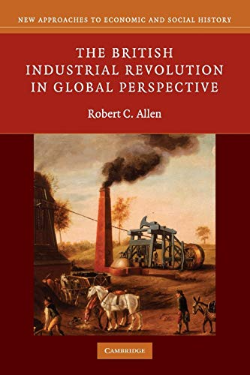
Economic history
Robert C Allen The British Industrial Revolution in Global PerspectiveRobert C Allen, The British Industrial Revolution in Global Perspective, Cambridge University Press, 2009 2009.
p6: The most important scientific discoveries related to atmospheric pressure, namely, the findings that the atmosphere had weight and that steam could be condensed to form a vacuum... How these ideas were discovered is a great story that involved many of the leading figures of seventeenth-century science – Galileo, Toricelli, Otto von Guericke, Robert Boyle, Robert Hooke, Christiaan Huygens and Denis Papin ... The culmination of these inquiries was Thomas Savery’s steam pump invented in 1698 and Thomas Newcomen’s steam engine of 1712. It was the technological wonder of the age, and one of the first examples of industrial technology derived from science…. The discoveries of seventeenth-century physics were necessary conditions for the invention of the steam engine, but they were not sufficient…. Turning the scientific knowledge into working technology was an expensive proposition...
p157: The inspiration for the steam engine was unusual, for it was an application of scientific discoveries of the seventeenth century….The link from science to the steam engine was direct.
p158: In 1675, Papin built the first, very crude, steam engine.
p159: Newcomen’s design was suggested by von Guericke’s apparatus. …This apparatus becomes a ‘steam engine’…
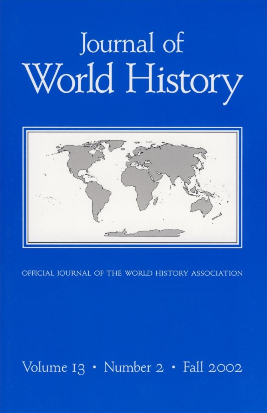
Jack Goldstone Efflorescences and Economic Growth in World History: Rethinking the "Rise of the West" and the Industrial RevolutionJack Goldstone, Efflorescences and Economic Growth in World History: Rethinking the "Rise of the West" and the Industrial Revolution, Journal of World History, 10456007, Fall 2002, Vol. 13, Issue 2. (web) 2002.
p367: The atmospheric engine, whose development led to the true steam engine, is only possible if one grants certain facts--that it is possible to create a vacuum, and that the pressure of the earth's atmosphere against such a vacuum is powerful enough to do useful work--and then uses those facts in the design of practical machines to do work. Yet these facts are not self-evident; indeed the possibility of a vacuum continued to be denied by Cartesian philosophers until late into the seventeenth century.
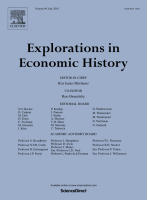
Joel Mokyr The past and the future of innovation: Some lessons from economic historyJoel Mokyr, The past and the future of innovation: Some lessons from economic history, Explorations in Economic History, Volume 69, 2018, Pages 13-26 (doi) . 2018.
p16: Newcomen's atmospheric engine required notions that had been developed by seventeenth-century experimental philosophers, above all the realization of atmospheric pressure and that a vacuum was possible and could be exploited (Wootton, 2015, pp. 500–508). It is undeniable that without the work of a long line of well-trained natural philosophers beginning with that of the Neapolitan Giambattista della Porta via the discovery of the atmosphere by Torricelli in 1643 and all the way to the experimental physicist Denis, Papin, who built the first workable model of an atmospheric engine in the 1690s, it is hard to see Newcomen's device succeeding (Kerker, 1961, Cohen, 2012, pp. 476–478, 729; Wootton, 2015, pp. 490–495).
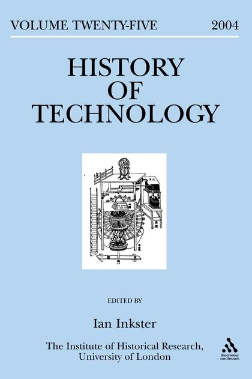
History of science
H. Floris Cohen The Rise of Modern Science as a Fundamental Pre-Condition for the Industrial RevolutionFloris Cohen, The Rise of Modern Science as a Fundamental Pre-Condition for the Industrial Revolution, 2000. (pdf) 2000, and Inside Newcomen's Fire Engine, or: The Scientific Revolution and the Rise of the Modern WorldFloris Cohen, Inside Newcomen's Fire Engine, or: The Scientific Revolution and the Rise of the Modern World, in in Inkster, Ian. History of Technology Volume 25, Bloomsbury Publishing Plc, 2004 2004.
p117: …there is no reasonable doubt that, whether directly or indirectly, Newcomen must have been aware of a sketch communicated by Denis Papin to the Royal Society and published in its Philosophical Transactions.
p118: It is that at the heart of the machine we find the incarnation of a scientific idea - an idea made flesh; an idea explicitly formulated and deliberately applied. It is, next, that that scientific idea, which is about the possibility of void space and of experimental proof for the effective voidness of certain spaces, was entirely unheard-of, without any precedent anywhere. It is, further, that that unprecedented scientific idea runs counter to any common-sense conception of nature.
p129: My mind boggles at the notion that it might ever have occurred to anyone anywhere to put together, just gropingly, a boiler, a cylinder, a piston, and an assembly fit to ensure regular condensation-cycles in a space regularly drawn void. Maybe it is just my mind that boggles, but at the very least the burden of proof rests upon those who fancy that there is no problem here at all, and that the West owes the prime power mover behind significant stages of its industrialization process to sheer chance.
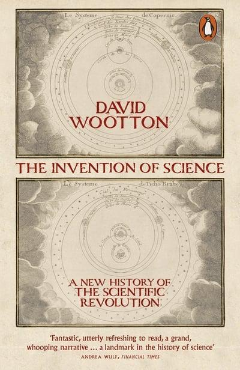
David Wootton The invention of science : a new history of the scientific revolutionDavid Wootton, The invention of science : a new history of the scientific revolution, Allen Lane, https://www.vlebooks.com, 2015. 2015.
p546: Newcomen picked up….where Papin began. In doing so he inherited some of the most advanced theories and some of the most sophisticated technology produced in the seventeenth century….First came the science, then came the technology.
p537: The first possibility is that he worked in complete isolation, without knowledge of anything that had gone before. One only has to formulate this possibility to see that it must be wrong. For a start, Newcomen could not have devised his engine without knowing about the pressure of the atmosphere, since this provides its driving force.
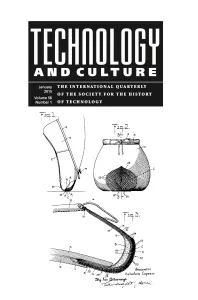
Technology and culture
Milton Kerker Science and the Steam EngineMilton Kerker, Science and the Steam Engine, Technology and Culture, Vol. 2, No. 4 (Autumn, 1961), pp. 381-390 JStor 1961.
p382-4: It is our feeling that there has been a strong interaction between science and steam engine technology, and in this paper we will call attention, very briefly, to some aspects of this interaction. …And so the stage was set for the great act of invention by Thomas Newcomen, using the principles first arrived at by Papin. …Contemporary records indicate that Hooke probably kept him [Newcomen] informed of Papin's progress, …the picture of steam engine technology that emerges is certainly more subtle than mere empiricism operating in the dark far from the light of science.

Eugene S. Ferguson The Origins of the Steam EngineEugene S. Ferguson, The Origins of the Steam Engine, Scientific American, Vol. 210, No. 1 (January 1964), pp. 98-107. 1964
p98: It has been said that science owes more to the steam engine than the steam engine owes to science. Such a generalization seems particularly inappropriate with respect to a machine that exemplifies the overlap between the empirical and the theoretical stages of the Industrial Revolution. …the sequence of ideas apparent in the work of Galileo, Torricelli and Pascal in establishing the fact of atmospheric pressure, and of von Guericke, Huygens and Papin in devising ways to make atmospheric pressure do work, was an indispensable prerequisite of the Newcomen engine.
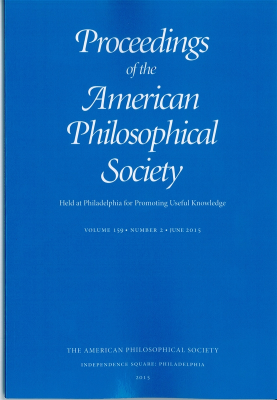
Harry Kitsikopoulos From Hero to Newcomen: The Critical Scientific and Technological Developments That Led to the Invention of the Steam EngineHarry Kitsikopoulos From Hero to Newcomen: The Critical Scientific and Technological Developments That Led to the Invention of the Steam Engine, Proceedings of the American Philosophical Society, Vol. 157, No. 3, September 2013 2013,
p305: …without the discovery of the vacuum the modern steam engine would not have emerged as a historical artifact.
It is clear that there is a considerable weight of argument in favour of the view that prevails in Wikipedia. Only one can be swiftly discounted: Kerker relies on Robison's imagined correspondence between Hooke and Newcomen as evidence for the interaction of science and the steam engine at that stage of its development.
Several of the rest share similar arguments and refer to similar evidence: these are examined in the next section. Two of the arguments are particularly detailed: The argument by Cohen, that only science could have brought the necessary elements of the engine design together, is examined subsequently; The argument by Wootton, based on a reading of a particular paper by Papin, is examined after that.
Arguments in common
- That the engine could only have been developed by people who knew about the principles of the vacuum and atmospheric pressure, discovered by scientific investigators.
- That these principles are counter intuitive, and could not be understood by Newcomen and Calley independently.
- That the technology of the air pump, developed for the scientific investigation of the vacuum, was used to develop the engine.
- That the arrangement of condensation, piston and cylinder used for an experiment on the power of the atmosphere by Denis Papin may have helped Newcomen to develop the fire engine.
The first three are examined immediately below; the fourth is addressed after some context has been provided by a summary of Papin's work around steam devices.
The principle of the atmosphere
The argument is that the scientific understanding of the atmosphere which came from 17th century scientific work was necessary for the development of the engine. This argument fails to explain how the suction pump could be developed in the 15th century, without the benefit of this scientific principle. Although we might today explain how the pump works in terms of the atmosphere that does not mean that the people who developed it were thinking about it the same way. They had plenty of experience with how fluid pressure works, and how suction could be achieved if a good enough seal could be made. Many technical, and scientific, advances have been made on the basis of incomplete or false understandings: for example Carnot's work on thermomechanical cycles was framed in terms of the caloric theory of heat, the first hot air balloons were supposed to obtain lift from the chemical nature of the products of combustion, Volta thought the electric current from his pile came from contact potential and not from electrochemistry. The case of the atmosphere is, on the contrary, an example of a phenomenon arising from technical practice preceding the science: the scientific investigation of air pressure followed from the practical limitation of the suction available from a suction pump.
Newcomen may have been aware of the concept of the atmosphere, for example from the use of the barometer for weather predictions. Barometric recordings in Paris date from 1665, but in England did not begin until 1697, after the time when Newcomen is thought to have started his engine development. Do not be misled by some authors' use of the term "atmospheric engine", this was a name given to the engine after it appeared, so it does not carry any implications about how it was developed.
With experience of fluid pressure and flow it is quite possible to think clearly about how the engine worked, even in ignorance of the scientific work on the atmosphere. For example, Isaac Beeckman, writing in 1614, thirty years before Torricelli's famous experiment: ...air, after the manner of
water, presses upon things and compresses them according to the depth of the
superincumbent air…. But things rush towards an empty space with great
force, on account of the immense depth of the superincumbent air, and in
this way the weight of the air arises.
(Knowles MiddletonW.E. Knowles Middleton, The history of the
barometer, 1964, p6).
The principles of the existence of the vacuum, and condensation

The argument is that the concept of the vacuum was necessary for the development of the engine. The first reason this argument fails is similar to the failure of the argument on the atmosphere: the engine could be developed without it. It was known at least 80 years before the scientific investigations of the vacuum that the condensation of steam produces a powerful suction, enough to draw water up several metres. No concern with the existence of the vacuum arises. The use of boiling and condensation has been made in distillation since ancient times. Ignorance of any fundamental principles relating to these things is no obstacle.
The second reason for the failure of the argument is that to the present day, engineers work not with the absolute pressure used in vacuum science, but with the pressure relative to atmospheric, known as gauge pressure. The indicator diagram (at right for a Newcomen engine), which displays the pressure in the cylinder around the cycle, is plotted with the pressure going negative of zero. This shows that, even in the knowledge of fundamental principles, we still think in more practical terms. There is no reason to believe Newcomen did otherwise.
The third reason for the failure of the argument is that the indicator diagram shows the cylinder pressure is at most two thirds of the way to a vacuum. This is because in practice, any further reduction in cylinder pressure increases the force, but slows the cycle down, reduces power, and reduces efficiency. The concept of the vacuum was, in three cases, an obstacle to the development of an engine. One case is of Martin Triewald Mårten Triewald's short description of the atmospheric engine, Stockholm, 1734, an enthusiast for the Fire Engine, who advocated reducing cylinder pressure to a vacuum as a way to increase the capability of the engine. Another case is Desaguliers (p468) who states that the force on the piston can be calculated by assuming a vacuum on the condensation side. The other case is of Denis Papin, whose work is discussed below.
Copying the air pump.
The air pump was less appropriate and less available to the developers of the engine than piston-cylinder suction pumps, then available at a bore of up to seven inches (Dickinson Henry Winram Dickinson, A short history of the steam engine , Babcock and Wilcox Ltd, 1938 ). The suction pump acts on air when it is started up, and may be primed with water to reduce leakage. The air pump of Hooke, and its developments by Papin, were suction pumps designed to produce a better vacuum. What was needed for the piston and cylinder of a successful engine was an arrangement that was mechanically efficient, robust and powerful: the air pump was none of these things.
Newcomen was an ironmonger, familiar with mine pumping equipment, and Calley, his co-worker, was a plumber. Such men were experienced in the effects of water pressure on pipework, and used to employing a piston-cylinder suction pump on a significant head of water. They would appreciate the action of negative (gauge) pressures as well as positive, and could calculate the force applied to a pump under these pressures. This is the practical experience and conceptual framework necessary for developing the engine.
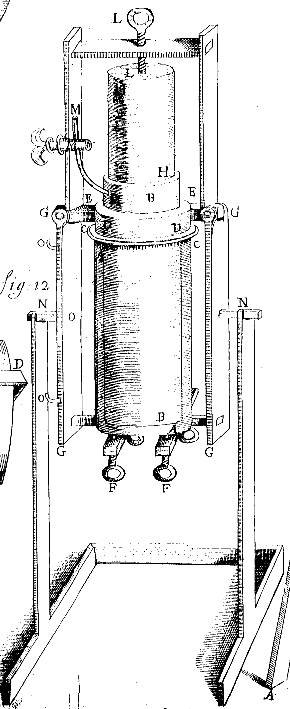
The work of Denis Papin
Two of Dr Papin's investigations have been highlighted as the key to the origins of the fire engine. The context of these investigations is significant in assessing their roles, so something of it is given here.
Papin's work was wide ranging, in subject and in character. He was born into the haute bourgeoisie, and worked at various times for the Lord of Zuilichem, the Royal Society of London, Marburg University, and the Landgrave of Hesse. Following investigations with Robert Boyle at the Royal Society of cooking with a "screwed Balneum Mariae", or pressure cooker, he produced the New Digester (1681), a practical manual describing how to construct, use and regulate the device, and the results of cooking with it.
In A Continuation of the new digester Denis Papin. A continuation of the New digester of bones. Printed by Joseph Streater, 1687 (1687) he describes more experiments carried out with a new, larger digester, an improved air pump arranged to conveniently evacuate a sample chamber, an arrangement so that the pressurised volume of the digester surrounds the evacuated chamber, and experiments applying vacuum with and without heat to carry out distillation on foodstuffs and other materials.
In Acta Eruditorum (1690) he publishes A method for large motive forces at low cost
and in the Recueil de diverses pièces touchant….
(1695) (Collection of various articles on new machines and other
philosophical subjects) he describes a centrifugal pump, a heat exchanger,
pneumatic power transmission, an actuator displacing high forces for low
cost, the design of pipework, air supply to a lantern under water, and a
submarine tank.
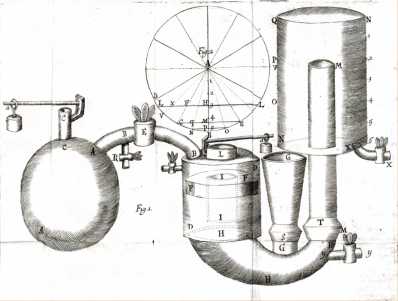
In Nouvelle manière pour lever l'eau par la force du feu
(1707) he describes a projected steam pump using positive pressure into a
cylinder containing a piston floating on the water to be pumped, proposing
steam at two atmospheres, red hot iron rods in a float in the steam chamber
which separates the steam from the water to be pumped and so reduces the
loss of steam to heating the water, and an air accumulator to smooth the
output flow. This was presented as an improvement on the Savery pump; A small scale model was constructed, but went no further.
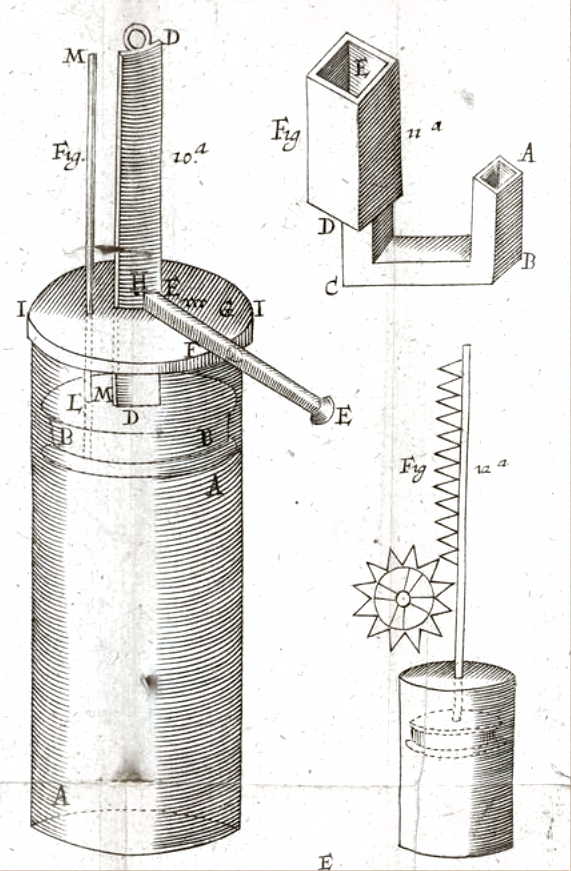
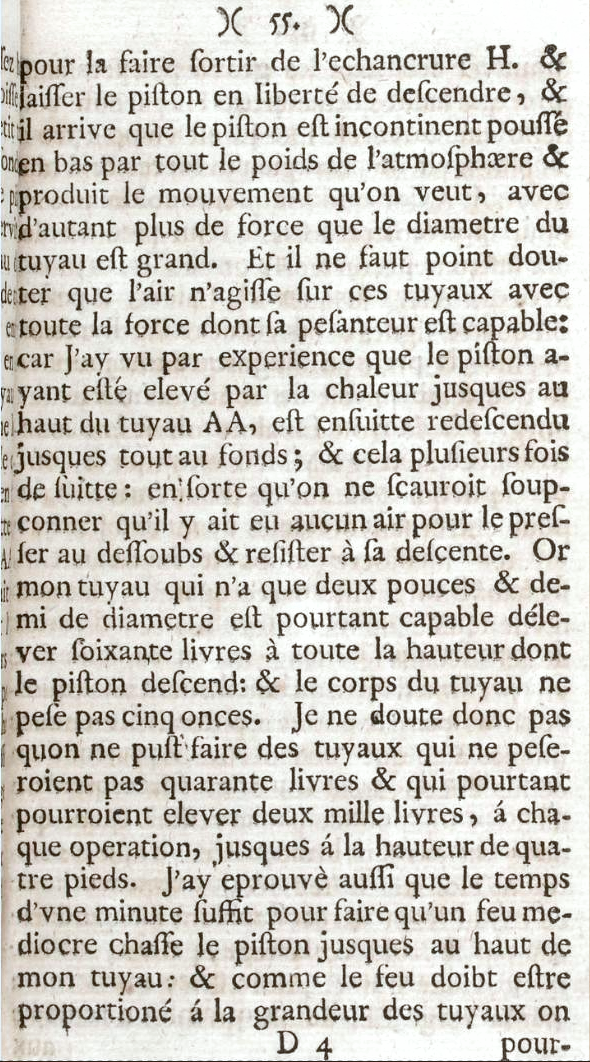
The condensation actuator
The device most often singled out as demonstrating the key principle of an atmospheric engine was described by Papin as "A new way of producing large forces for low cost". His drawing of it is Fig 10 on the right, and the account of his experiments and deductions is on the left. It is described as an improvement on a previous device using gunpowder to expel the air from the tube AA in an attempt to create a vacuum and hence obtain the effect demonstrated by von Guericke using an air pump. Papin explains that when water is boiled the steam has a pressure like the atmosphere, and when it is recondensed no trace of that pressure remains. He believed that in this way water could produce a perfect vacuum which it would not be difficult to put to use in machines.
The device is a piston-cylinder actuator which draws the rod DD in by the condensation of steam in the tube AA (which is closed at the lower end). His operating instructions are to remove the piston and the rod MM, add about a centimetre of water to the tube, insert the piston and push it down until water comes out of the hole L, screw the rod MM into L to seal it off, and replace the cover and spring loaded catch EE. Then put the tube over a moderate fire so that the water boils, drives the piston up until the lock enters a recess in the rod to retain it. The fire must be immediately removed, the tube will cool rapidly, the steam will condense and the catch may be released to deliver the desired movement, under the full weight of the atmosphere.
Papin reports that he has tested repeatedly heating and cooling the device, and the piston returns to the same starting position, which proved beyond doubt that there was no air under the piston to resist its descent. He says that then, despite its diameter of only 2.5 inches his cylinder is capable of delivering 60lbs force over the full height of the piston's descent. He does not say that he has tested that capability: it appears that he is deducing it from his experimental verification of the complete exclusion of air.
The necessity of the spring lock is not obvious. It gives an audible warning that the piston is fully raised, and that heating must stop immediately or the cylinder may explode. The lock makes demonstrating movement of the piston more controllable: without the lock the piston would start to move while the rearrangement of fire and cylinder was under way. The lock offers the possibility of delivering a force via a mechanism, but no trial of that is reported.
He does not describe any seal being fitted between piston and cylinder, just that they are close fitting. Without a seal there must have been leakage if there was any load on the piston. With a seal, there would be force lost to friction as the piston descended. It seems that the experimental operation of the cylinder was limited to traversal under no load. In practice any leakage of air past the piston would make the available travel of the piston reduce substantially at each cycle.
The light weight of the tube is a feature of the device: Papin previously remarked (A Continuation… p54) on how a light tube can resist being evacuated. The lightness of the tube is described as important for achieving a heating time of one minute. The tube is described as 2.5 inches in diameter and weighing five ounces, and from the figure the length appears to be about ten inches. This implies a wall thickness of only 0.4mm in copper. For comparison the thickness of a modern tin can is 0.3mm in steel, and the lightest gauge of modern copper tube at that diameter is about 1.5mm. It is remarkable that contemporary tube drawing could produce a cylinder of that size, uniform enough to resist buckling collapse if it were evacuated. Even a perfect tube of that length would be at over 30% of the theoretical pressure it could ideally resist, and any non-uniformity would reduce the resistance drastically.
Papin does not report ever having subjected the device to sustained vacuum or traversal under power. Had he done so, the thin cylinder wall would have been liable to implode. Undeterred by the lack of any demonstration that his device will deliver power, Papin goes on to propose the development of an engine using a cylinder ten times larger. He suggests such tubes could be made cheaply in a dedicated factory, and that the actuator could be connected to a rack and pinion drive, with a ratchet to produce unidirectional motion. He suggests that among many possible uses were pumping out mines, rowing, and throwing bombs. Finally, he describes an improved furnace which might achieve a heating time of 15 seconds, and proposes that actuators should be carried to the furnace to be heated, then taken to the place where the force is required, and discharged, thus obviating the rack and pinion.
The quotations from engineering treatises above refer to projectors, and their vague ideas of improvement which have little merit. Papin's speculation, in which a complete power system is conjured from a flimsy demonstration, is an example of what they are referring to. The vision of these delicate cylinders, each liable to explode if left in the fire too long, locking in a force of several tonnes and weighing well over 150 Kg, being taken from the furnace to a pump where the force is released evokes a scene worthy of the Grand Academy of Lagado.
The possible contribution of the condensation actuator to the development of the fire engine
It is possible that Newcomen was aware of the work on the actuator: what might that awareness contribute to the development of the engine? Papin combines the condensation of steam and a piston-cylinder device, the same pairing as Newcomen was working with. The outcome of Papin's work was not encouraging: his proposal requires a portable, thin walled cylinder, which can resist repeated heating and cooling, contains a fixed mass of water, and houses a piston which seals perfectly. He has calculated what the force on the piston would be if the space beneath it were evacuated, but Newcomen could obtain a similar estimate from knowledge of the limit of suction pump operation.
The technical problems that were overcome in developing a working engine are described on the Raising water page. Papin's arrangement does not show what is needed to make an engine that combines the condensation of steam with a piston-cylinder. Papin himself turned away from this arrangement, and tried instead for an arrangement with positive steam pressure and direct action of the piston on the water to be pumped. Anyone attempting to follow his earlier proposals would have been similarly discouraged.
The argument that science brought the design elements together
My mind boggles at the notion that it might ever have occurred to anyone anywhere to put together, just gropingly, a boiler, a cylinder, a piston, and an assembly fit to ensure regular condensation-cycles in a space regularly drawn void. Maybe it is just my mind that boggles, but at the very least the burden of proof rests upon those who fancy that there is no problem here at all, and that the West owes the prime power mover behind significant stages of its industrialization process to sheer chance. (CohenFloris Cohen, The Rise of Modern Science as a Fundamental Pre-Condition for the Industrial Revolution, 2000. (pdf), p7).
Cohen's argument is based on the improbability of a coincidence that all of the correct four elements were chosen for the engine without the benefit of scientific principles. Of the four, only one, the void, was particularly a subject of scientific interest, the other three were part of the technical environment. This environment includes an understanding of the mechanics of these three elements, which was established independently of the novel scientific ideas of the atmosphere. Therefore, the use of scientific principles does not explain how the successful arrangement of the design elements was made, and the argument is reduced to the claim that the void is essential to the development of the machine, which has been rejected above. In any case, then as now, the successful choice of design elements is only partly dependent on principles of any kind. The more important contribution comes from knowledge of the available technology, and its performance in practice.
Cohen's description of technical development without science as entirely random is extreme, but the point remains that it has to be proved that a successful engine could be developed with just technical experience, experiment and calculation. The burden of this proof is sustained on the Raising Water page, which shows how the understanding and experience of mechanics and pumping systems were what was needed to develop the fire engine. These understandings are sufficient to inform the successful development of the engine, when combined with the technical resources and economic rewards in play at the time.
A specific argument concerning Papin’s influence on Newcomen
Wootton argues that Newcomen had no knowledge of the actuator, but instead was furnished with the elements of the fire engine by Papin's "Continuation of the new digester".
With a copy of the "Continuation" in his hands, Newcomen would have known almost everything that Papin know about how to harness atmospheric pressure to build an engine. All the bits and pieces were there; all he had to do was recognize how they could be assembled to serve a new purpose...WoottonDavid Wootton, The invention of science : a new history of the scientific revolution, Allen Lane, https://www.vlebooks.com, 2015. p507.
This argument is prompted by the evidence that Papin's Continuation of the new
digester
was readily available to Newcomen, whereas the description of the vacuum actuator was not. According to Wootton many of the enabling steps that Newcomen needed
to develop the engine were described in the "Continuation". He itemises these as:
- the use of steam with a piston-cylinder;
- a wetted leather washer seal;
- a safety valve;
- automatic valve operation;
- confidence that the poor performance of the model engine would improve when it was scaled up.
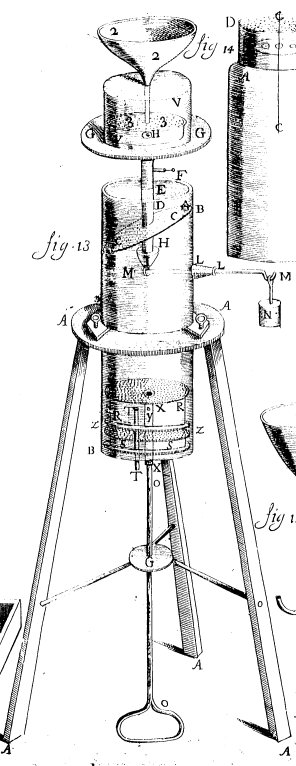
The first step in the list is clearly central to the Newcomen engine; according to Wootton the relevant passages in the Continuation describe firstly the possible use of a piston-cylinder to launch a projectile, and secondly three references to the use of external cooling water to condense steam and produce a vacuum. The first passage is supposed to be the means for Newcomen to realise that atmospheric pressure exerted on a piston could drive a machine. There are more apposite reasons to expect Newcomen to anticipate that possibility: his practical experience of the downward force on the actuator of a pump due to the weight of water being lifted, for example, is much closer to the action of an engine than are theories of a vacuum gun. None of the second set of passages actually refer to condensation of steam to produce a vacuum; they refer instead to the use of cooling to condense distillates, and the boiling of water in vacuo at low temperatures.
The second step, the use of some form of seal (greased wool, leather), is familiar from the operation of pumps, and the use of water to improve sealing is familiar from priming an empty lift pump with water to get it started.
The third step, the safety valve, did not appear in a fire engine until after the first engine was installed; the manual valve gear employed in early development provided the function of a safety valve anyway. Papin did not use a safety valve in the Continuation digester, despite its working pressure of about 8 bar, and preferred instead to use the timing of the evaporation of a drop of water to estimate the working temperature, a procedure he had developed for the first digester.
The fourth step, the use of automatic valves, was also not part of the earliest developments. That sort of mechanism could only be implemented once a hand operated engine has been developed. The practice of automatic mechanisms was well established, often associated with clocks; the challenge for the Newcomen engine was to make something reliable and robust enough to trust in control of a powerful machine.
The fifth step, an example of a scaling calculation, was already familiar from sizing pumps by considering the head of water and cylinder dimensions. The argument that if they did not have confidence in a scaling calculation they would have abandoned development is contradicted by the evidence that they constructed a machine with external cylinder cooling which was not economical to run. According to Wootton, their calculations would have made them abandon the project before doing that.
The Continuation of the new digester is an interesting extension to Papin's record as an ingenious and practical experimenter, but it has nothing to do with the fire engine, in form or purpose. Wootton likens the development of the fire engine to a locked room mystery. Reviewing the evidence, it seems that Papin's work was a red herring, and the keys were lying in the ironmonger's back yard.
Review
The arguments and evidence presented in this section which support the prevailing view have been examined in some detail above. The issues addressed are the necessity of concepts, and the possible assistance of the scholars' experiments, in the development of the Newcomen engine. There remain the issues of whether Newcomen's practice could provide the required experience and understandings, and whether the wider technical activities of scholars were of assistance. These are addressed on the Raising Water page.
The activities of Thomas Savery were contemporary with the development of the engine, and well publicised. It is these activities that Friedel suggests were inspiration for Newcomen's use of condensation, and so provided at least some small contribution to his success. This may well be, but if we are to consider Savery's arrangement as a source of inspiration, we must take all of it into account in weighing it's contribution, not just the part in common with Newcomen's engine. Savery, and others with scholarly connections, persisted in trying to use positive steam pressure, and avoided piston and cylinder mechanisms in their steam pumps. Newcomen only succeeded because he chose not to follow their example. If the contribution of their work is reckoned by what it would inspire, the balance comes out negative.
Review
The views on the origins of the early steam engine that have been examined in the five sections on this page relate fairly clearly to the interests and readership of their authors. Is there any reason to prefer one view to another? Is it of any importance which view should prevail?
All parties are agreed that Newcomen and his associates designed, developed, constructed and installed the early engines, and that this was a remarkable achievement of lasting significance. In their treatises the engineers celebrate this triumph of the artisans. They also detail how the elements of the design were all available many years before the scholars turned their attentions to investigating them. The engineers could quite understand that artisans succeeded on their own where contemporary scholars had failed, but academic authors believe that to be impossible. One of them, Dr Robison, imagined evidence to sustain his belief.
This page has subjected the arguments of present day academic authors to a careful examination, but has not paid the same attentions to the engineers'. This is because the engineers were writing under the impression that Dr Robison's report was genuine, and that there was evidence of a scholar intervening in the development of the engine. Their arguments were directed to showing that the intervention was trivial, but with the debunking of the evidence these arguments are redundant. Their case becomes one of claiming that the artisans could carry out the development with their own resources: this is examined on the Raising Water page.
The problems with the arguments of the present day authors are encapsulated in one example:
Newcomen had little formal education. … Yet, almost singlehandedly …he brought a new technology into existence. How was this possible? The first possibility is that he worked in complete isolation, without knowledge of anything that had gone before. One only has to formulate this possibility to see that it must be wrong. For a start, Newcomen could not have devised his engine without knowing about the pressure of the atmosphere, since this provides its driving force.
The first part of the argument describes Newcomen's environment as complete isolation
; the term is clearly not meant literally, but it disguises the assumption that to be cut off from the work of scholars is to be bereft of assistance. Well known accounts of his environment describe the rich experience and network of connections that a man in his position had with mining and other engineers and their equipment. The argument addresses a technical development, yet does so as if technical issues had no existence. The second part of the argument is absurd. The Newcomen engine interacts with the atmosphere in the same way as you do when drinking through a straw. It appears that a range of great apes have spontaneously invented the drinking straw (Héctor Marín Manrique and Josep Call Manrique HM, Call J, Spontaneous use of tools as straws in great apes. Anim Cogn. 2011 Mar;14(2):213-26. doi: ). According to this part of the argument they could not do this without prior knowledge of the atmosphere.
The problems with the arguments are compounded by citation of sources that are unreliable or misinterpreted. Kerker cites Robison's imagined evidence, and Mokyr cites Kerker. In another example of an imagined contribution by a scholarly researcher to technology, WoottonDavid Wootton, The invention of science :
a new history of the scientific revolution, Allen Lane, https://www.vlebooks.com, 2015. reports (p519) that Hooke designed the first machine to produce identical gears, thus making possible the mass production of machinery
. In support, he cites AllenRobert C Allen, The British Industrial
Revolution in Global Perspective, Cambridge University Press, 2009 (p205): Their [clocks and watches] moving parts were systems of gears, and each had to be laid out and cut by hand. Hooke designed the first machine to do this (Weiss 1982, pp. 153–6)
. Actually, Weiss's analysis of the evidence is that the gradual mechanisation of gear cutting underwent a notable improvement by artisans in Lancashire, and, probably after consultation with them, Hooke had his new machine made.
It is clear that the strong assertions of the academic authors are not substantiated by valid arguments and sound interpretation of evidence. There is insufficient reason to prefer their view that in this case the the science led and technology followed. The second question is whether a sound view of this historical development is of wider significance. That this is so is demonstrated on the Technology, research, development, and science page and the Technology and science education page. The histories of science and technology are often referenced in support of policies for research or educational curriculum development. These policies are subject to pressure from interested parties; it is important that there is a reliable research base against which their claims can be tested.
There is a problem of circularity here: the Technology and science education page describes how, in England and the USA, science takes precedence over technology in general education. This education teaches that the route to understanding technology is through the analysis in terms of core disciplinary ideas from the sciences. Those who carry out in depth research in the histories of science and technology are aware that technology is not just the application of science, but may still frame their analysis of technology in terms of science. In this framing, the arrangement of the Newcomen engine is obviously inspired by the experiments of von Guericke, which demonstrated the dramatic force of the atmosphere. In a technical framing, the arrangement poses a question: why not choose the much greater power of steam pressure? it is the answer to this question that gives the insight into how the successful arrangement arose.
Conclusions
are drawn together on the Introduction and conclusion page.
References
- ^ Sungook Hong (1999) Historiographical layers in the relationship between science and technology, History and Technology, 15:4, 289-311, DOI:10.1080/07341519908581950
- ^ Did Science Cause the Industrial Revolution? Cormac Ó Gráda, Journal of Economic Literature 2016, 54(1), 224–239, http://dx.doi.org/10.1257/jel.54.1.224
- ^ George Wise, Science and Technology, Osiris, 2nd Series, Vol. 1, Historical Writing on American Science. (1985), pp. 229-246, p236
- ^ Rhys Jenkins, The Heat Engine Idea in the Seventeenth Century, Transactions of the Newcomen Society, 17:1, 1-11. DOI
- ^ H W Dickinson, A short history of the steam engine, Babcock and Wilcox Ltd 1938
- ^ R. L. Hills A One-Third Scale Working Model of The Newcomen Engine of 1712, Transactions of the Newcomen Society, 44:1, 63-77 (1971), DOI
- ^ An Encyclopedia of the History of Technology, Ian McNeil, London: Routledge, 1990. web
- ^ Milton Kerker, Science and the Steam Engine, Technology and Culture, Vol. 2, No. 4 (Autumn, 1961), pp. 381-390 JStor
- ^ George Basalla, The evolution of technology, 1988
- ^^ Floris Cohen, The Rise of Modern Science as a Fundamental Pre-Condition for the Industrial Revolution, 2000. (pdf)
- ^ Floris Cohen, Inside Newcomen's Fire Engine, or: The Scientific Revolution and the Rise of the Modern World, in in Inkster, Ian. History of Technology Volume 25, Bloomsbury Publishing Plc, 2004
- ^ Jack Goldstone, Efflorescences and Economic Growth in World History: Rethinking the "Rise of the West" and the Industrial Revolution, Journal of World History, 10456007, Fall 2002, Vol. 13, Issue 2.
- ^ Joel Mokyr, The past and the future of innovation: Some lessons from economic history, Explorations in Economic History, Volume 69, 2018, Pages 13-26 (doi) .
- ^^ Robert D Friedel, A culture of improvement: technology and the Western millennium, Cambridge, MA : MIT Press, 2007
- ^ Robert C Allen, The British Industrial Revolution in Global Perspective, Cambridge University Press, 2009
- ^ Harry Kitsikopoulos From Hero to Newcomen: The Critical Scientific and Technological Developments That Led to the Invention of the Steam Engine, Proceedings of the American Philosophical Society, Vol. 157, No. 3, September 2013
- ^ Eugene S. Ferguson, The Origins of the Steam Engine, Scientific American, Vol. 210, No. 1 (January 1964), pp. 98-107.
- ^^ David Wootton, The invention of science : a new history of the scientific revolution, Allen Lane, https://www.vlebooks.com, 2015.
- ^ W.E. Knowles Middleton, The history of the barometer, 1964
- ^ Henry Winram Dickinson, A short history of the steam engine , Babcock and Wilcox Ltd, 1938
- ^ Mårten Triewald's short description of the atmospheric engine, Stockholm, 1734
- ^ Denis Papin. A continuation of the New digester of bones. Printed by Joseph Streater, 1687
- ^ Manrique HM, Call J, Spontaneous use of tools as straws in great apes. Anim Cogn. 2011 Mar;14(2):213-26. doi:
